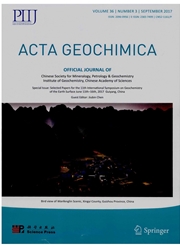

 中文摘要:
中文摘要:
腐殖的酸的特征和分布(哈) 并且在黄土壤侧面和西南中国石灰岩地区常见的地形区域的石灰石土壤侧面的土壤有机物(SOM ) 系统地被调查在学习区域的不同土壤揭示他们的进化。结果证明沿着二的 SOM 的特征和分发玷污侧面是尤其是不同的。土壤样品的全部的器官的碳(TOC ) 内容就沿着黄土壤侧面沿着石灰石土壤侧面,但是严厉地稍微减少了。石灰石土壤的 TOC 比相应黄土壤的那些显著地高,并且 SOM 的 C/N 比率显示出一个类似的变化趋势到 TOC 的,显示那 SOM 能更好比的在石灰石土壤被保存在黄土壤。土壤腐殖的酸用尽一切地被提取并且用 ultrafiltration 技术根据他们的明显的分子的重量推进 fractionated 探索内在的保存机制。结果显示出那 C/N 比率从不同石灰石土壤层有是相对稳定的并且那大分子哈部分支配了最高的土壤的体积 HA,显示那哈当简历和化学降级被延迟时,在石灰石,侧面被保护。与器官的元素内容和二土壤的矿物质内容结合了,我们断定在石灰石土壤的高钙内容可以由形成 complexation 混合物与在 SOM 保存起一个关键作用或 / 并且与 hypergene CaCO 3降水围住 SOM。
 英文摘要:
英文摘要:
Characteristics and distributions of humic acid(HA) and soil organic matter(SOM) in a yellow soil profile and a limestone soil profile of the southwest China Karst area were systematically investigated to reveal their evolutions in different soils of the study area. The results showed that characteristics and distribution of SOM along the two soil profiles were notably different. Total organic carbon(TOC) contents of soil samples decreased just slightly along the limestone soil profile but sharply along the yellow soil profile. TOCs of the limestone soils were significantly higher than those of the corresponding yellow soils, and C/N ratios of SOMs showed a similar variation trend to that of TOCs, indicating that SOM can be better conserved in the limestone soil than in the yellow soil. The soil humic acids were exhaustively extracted and further fractionated according to their apparent molecular weights using ultrafiltration techniques to explore underlying conservation mechanisms. The result showed that C/N ratios of HAs from different limestone soil layers were relatively stable and that large molecular HA fractions predominated the bulk HA of the top soil, indicating that HA in the limestone profile was protected while bio and chemical degradations were retarded. Combined with organic elements contents and mineral contents of two soils, weconcluded that high calcium contents in limestone soils may play a key role in SOM conservation by forming complexation compounds with HAs or/and enclosing SOMs with hypergene CaCO_3 precipitation.
 同期刊论文项目
同期刊论文项目
 同项目期刊论文
同项目期刊论文
 期刊信息
期刊信息
